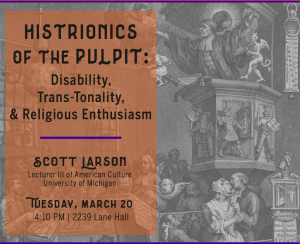Histrionics of the Pulpit: Disability, Trans-Tonality, and Religious Enthusiasm


Early Evangelical cultures – the radical revivalists of the 18th century who sought to feel, sensibly, their new birth and warming of the heart – offer a surprising chapter in trans histories. While few of these religious radicals claimed explicit experiences that would fit any definition of contemporary “trans” identity, they nonetheless embraced a new transformed tone of sensation and expression that transformed gender in revival spaces and devotional practices. The fever pitch of inspired preaching inflamed the passions, and disordered the mind and the senses. Even the “Father of American Evangelicalism,” George Whitfield, described his conversion and preaching as a trans-gendering labor: he was a woman in travail, “crying out” and “delivering” the New Birth to his hearers. Female preachers – especially women of color -- were deemed masculine in their visage and vocal tone as they exhorted and responded to spiritual conviction. Some specifically claimed spiritual genderlessness, and performed this transformed divine identity through "grum and shrill" preaching tones.
These cultural debates over the “trans-ing” of religious tone persisted through the nineteenth century, with fears of religious madness, “feminizing” devotional practices, and the political masculinization of evangelical women. In this sense, trans-tonality helps investigate trans/gender history beyond contemporary questions of identity, and poses new relationships between trans histories, disability studies, and religious cultures.
Speaker Bio:
Scott Larson is a Lecturer III of American Culture at the University of Michigan, Ann Arbor. His research and teaching focus on transgender studies, history of gender and sexuality, and early American culture. He is a scholar of religion, secularity, and sexuality with a focus on the early Anglophone Atlantic world. His work has appeared in the Journal of Early American Studies and on Notches history of sexuality blog. He received a M.A. in Theology at Yale Divinity School and received his Ph.D. in American Studies at George Washington University in 2016.
Cosponsored by the Department of American Culture.
